Bridging the divide – A battle of perceptions and realities

By Armour Roof Co.
Navigating workplace tensions to create unity and respect.
In today’s workplaces, the divide between blue-collar and white-collar workers isn’t just about job titles — it’s a complex web of perceptions, stereotypes and often unspoken conflicts. While blue-collar workers are seen as the backbone of hands-on industries, white-collar employees are frequently viewed as out-of-touch office dwellers. These perceptions fuel an invisible rift that can impact communication, resource allocation and overall team morale. But what if the key to a more harmonious work environment lies not in erasing these differences, but in understanding and appreciating them? Discover tools to aid in creating a more harmonious work environment with the help of Armour Roof Co.
Common perceptions and stereotypes
-
Blue-collar workers are often perceived as less educated, less skilled and more physically demanding in their roles. This can lead to a sense of superiority among white-collar workers.
-
White-collar workers are often seen as ‘office dwellers’ with less practical experience and an inflated sense of importance. Blue-collar workers may view them as disconnected from the ‘real world.’
What are the sources of conflict between blue- and white-collar workers?
-
Communication breakdown: Different communication styles and expectations can lead to misunderstandings and resentment.
-
Resource allocation: Competition for resources like equipment, budget or staff can create tensions between departments.
-
Work-life balance: Differing work schedules and expectations can contribute to friction.
-
Recognition and reward: Disparities in compensation, benefits and recognition can foster feelings of inequality.
-
Stereotyping and prejudice: Preconceived notions about the other group can hinder collaboration and respect.
How can I work as a property manager to building bridges?
-
Open communication: Encourage open dialogue and feedback between departments.
-
Cross-training: Provide opportunities for employees to experience different roles.
-
Shared goals: Establish common objectives that require collaboration.
-
Respect and appreciation: Foster a culture of mutual respect and recognition.
-
Leadership involvement: Strong leadership can bridge the gap and promote unity.
Overcoming challenges
-
Empathy and understanding: Encourage employees to see things from each other’s perspective.
-
Collaboration: Create opportunities for joint projects and problem-solving.
-
Clear roles and responsibilities: Define clear expectations and boundaries.
-
Fairness and equity: Ensure fair treatment and equal opportunities for all employees.
Showing appreciation to blue-collar workers
Blue-collar workers are the backbone of many organizations. Showing appreciation for their hard work can significantly boost morale and productivity. Our team at Armour Roof Co. is built on the grit, tenacity and hard work of the applicators on our team. We know that while the office team is in the AC in the office, our applicators are often on metal roofs where temperatures can rise to the triple digits. We make it a point to constantly provide thanks, feedback and ‘atta boys’ around the office, but more importantly, we implement tangible appreciation.
What are tangible appreciation and incentives?
-
Competitive wages and benefits: Ensure fair compensation and benefits packages.
-
Bonuses and incentives: Offer performance-based bonuses or incentives.
-
Paid time off: Provide generous vacation and sick leave policies.
-
Employee assistance programs: Offer programs to support employee well-being.
What are examples of intangible appreciation?
I always like to ask a leadership team at a job interview or another time where I am learning about their culture this question: As an employee in today’s job landscape, we often see our coworkers and teammates more hours a day than we do our own families. Besides a paycheck or benefits plan, what do you do as a company for your employees to let them know they are seen, heard and appreciated? You will be surprised how frequently leaders say that’s the first time this question was posed to them. We call those items intangible appreciation points.
-
Regular recognition: Acknowledge their contributions publicly and privately.
-
Open communication: Create channels for open and honest communication.
-
Opportunities for growth: Offer training and development opportunities.
-
Respectful workplace: Foster a positive and respectful work environment.
-
Employee of the month/quarter: Implement recognition programs.
-
Small gestures: Provide snacks, drinks or meals on occasion.
How to expand on appreciation
-
Team building events: Food brings everyone together and is a great way to have a meal and find common ground. Put in the time. Regularly interact with your team to understand them and so they feel comfortable to open up about their challenges. Host quarterly team outings to foster morale and encourage interactions that normally don’t have much interaction.
-
Taking the time to learn about coworkers out of the office, their families. You may or sadly may not be surprised that to some companies you are just a number. You clock in and clock out. Life happens. When you work somewhere that sees you as more than just a butt in a seat, you statistically work harder for that company and are more invested.
-
Support their off-time endeavors: support them in their passions outside of work. Go see them in the local production, go watch them preach on Sunday, go to the car show. Get invested in what brings your coworkers joy. They will then return the favor with the same spark for contributing in their job.
Implementing teamwork
By demonstrating teamwork, a property manager sets a positive example for their staff and creates a more productive and enjoyable work environment. Teamwork is a cornerstone of successful property management. A property manager who can effectively foster collaboration and cooperation within their team can reap numerous benefits. Break down the separation and stereotypes of different roles on the team. When everyone feels seen and included, everyone wins. Develop a sense of empathy and understanding of the challenges and workload and conditions of your teammates.
At Armour Roof Co. we know that without the literal sweat and hard worked days of our applicators, there would be no business for the office staff to run. We would have no product to sell, nothing to market or showcase. Our core values are the same for the office staff and our work crews:
-
Team player: helps others win by working toward the collective goal of the team
-
Excellence: pursues excellence in all aspects of your role by getting better every day
-
Positive attitude: maintains a consistently positive attitude to internal and external stakeholders
-
Driven and persistent: never gives up and works through challenges and obstacles
We’d love to hear ways you bridge the gap and show your team they are trusted, valued and seen!
Original article and photo source: Armour Roof Co.
Learn more about Armour Roofing Co. in their Coffee Shop Directory or visit www.armourroofco.com.







Comments
Leave a Reply
Have an account? Login to leave a comment!
Sign In